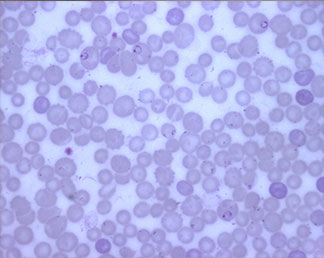To date, the unavailability of the in vitro continuous culture of P. vivax imposing major obstacle for the study of any stages of the life cycle of this parasite. The routine studies of P. vivax solely depend on the variable clinical isolates obtain directly from patients. Humanized mouse model engrafted with human hepatocytes has been successfully used to study the complete life cycle of P. falciparum. The use of humanized mouse model to study P. vivax would constitute a major breakthrough and revolutionized the way that this unique parasite can be studied in laboratory.
Both liver stage schizont and hypnozoite have been observed. Moreover reactivation of the hypnozoite has been observed. The in vivo study of P. vivax *using humanized mouse model engrafted with human hepatocyte is the research collaboration between MVRU and Dr. Sebastian from CIDR, and MVRU and Prof. Osamu Kaneko from Nagasaki university. There are 2 humanized mouse models that effectively used for in vivo study of *P. vivax at MVRU, FRG-NOD and PXB mice. Both models support liver stage development and liver-to-blood stage transition of P. vivax which revolutionized the way that this parasite can be studied in laboratory. By injecting P. vivax sporozoites through tail vein, they can invade and develop inside the engrafted human hepatocytes with both active and dormant forms (hypnozoite) have been observed. In addition, by injecting human young red blood cells to catch up free merozoites that released from the liver, tightly synchronized blood stage can be obtained. This has opened a wide opportunity to study in vivo drug and vaccine’s efficacy against liver stage and blood stage of P. vivax.
During malaria elimination era, multiple measures and stringent control strategies are needed in order to completely eliminate malaria. One of the big challenge to eradicate P. vivax is the hypnozoite (dormant form that stay in the liver) which can cause relapse at any time after clinical malaria episodes. The drug that target the hypnozoites would help to protect patients from relapse. Beside primaquine and tefenoquine, there is no new drugs available in the pipeline. The use of humanized mouse model to study P. vivax has constituted a major breakthrough and revolutionized the way to test drug and vaccine’s efficacy in laboratory.




